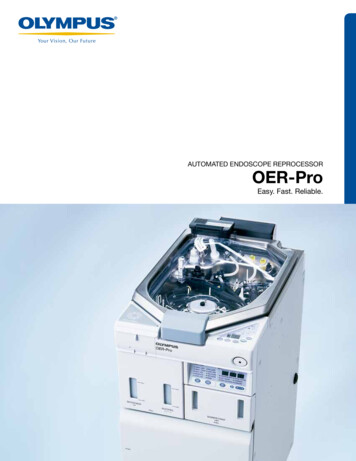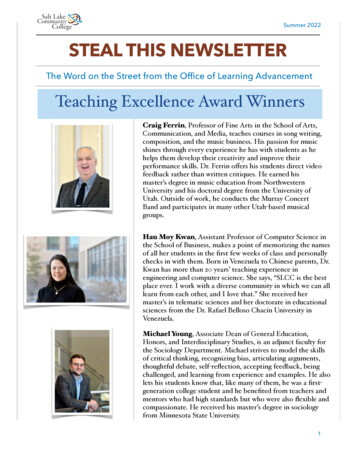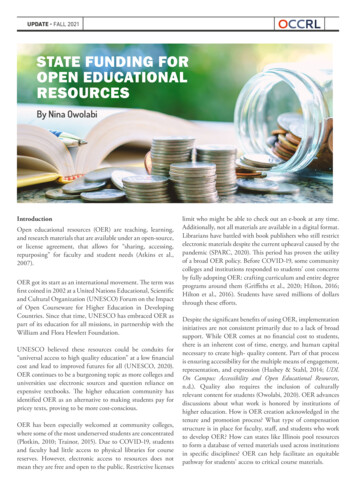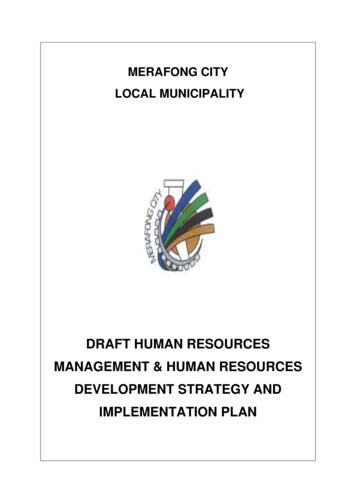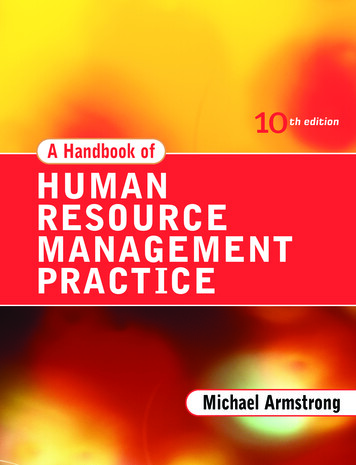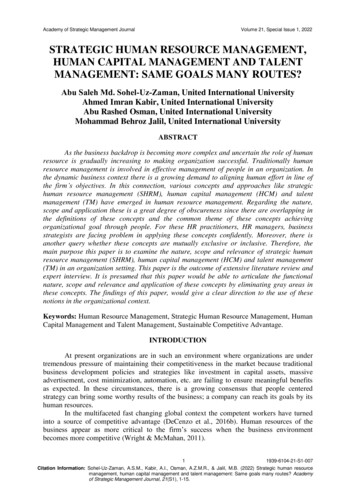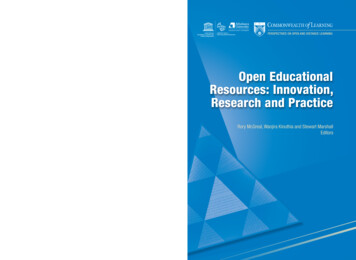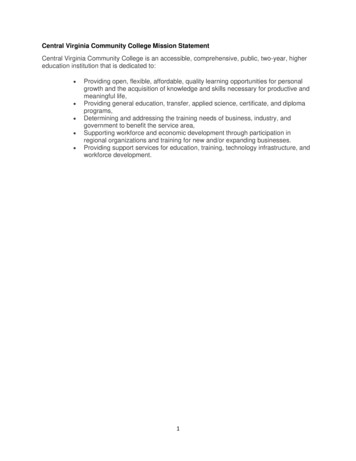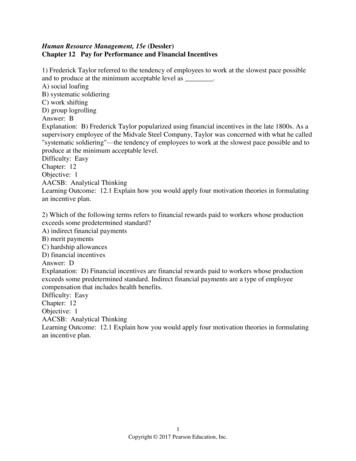
Transcription
Human Resource Management, 15e (Dessler)Chapter 12 Pay for Performance and Financial Incentives1) Frederick Taylor referred to the tendency of employees to work at the slowest pace possibleand to produce at the minimum acceptable level as .A) social loafingB) systematic soldieringC) work shiftingD) group logrollingAnswer: BExplanation: B) Frederick Taylor popularized using financial incentives in the late 1800s. As asupervisory employee of the Midvale Steel Company, Taylor was concerned with what he called"systematic soldiering"—the tendency of employees to work at the slowest pace possible and toproduce at the minimum acceptable level.Difficulty: EasyChapter: 12Objective: 1AACSB: Analytical ThinkingLearning Outcome: 12.1 Explain how you would apply four motivation theories in formulatingan incentive plan.2) Which of the following terms refers to financial rewards paid to workers whose productionexceeds some predetermined standard?A) indirect financial paymentsB) merit paymentsC) hardship allowancesD) financial incentivesAnswer: DExplanation: D) Financial incentives are financial rewards paid to workers whose productionexceeds some predetermined standard. Indirect financial payments are a type of employeecompensation that includes health benefits.Difficulty: EasyChapter: 12Objective: 1AACSB: Analytical ThinkingLearning Outcome: 12.1 Explain how you would apply four motivation theories in formulatingan incentive plan.1Copyright 2017 Pearson Education, Inc.
3) A management approach based on improving work methods through observation and analysisis known as .A) strategic managementB) scientific managementC) management by objectivesD) performance managementAnswer: BExplanation: B) Frederick Taylor spearheaded the scientific management movement, amanagement approach that emphasized improving work methods through observation andanalysis. Taylor also popularized the use of incentive pay as a way to reward employees whoproduced over standard.Difficulty: EasyChapter: 12Objective: 1AACSB: Analytical ThinkingLearning Outcome: 12.1 Explain how you would apply four motivation theories in formulatingan incentive plan.4) Who proposed a two-factor theory that explains how motivator factors relate to satisfactionand hygiene factors relate to dissatisfaction?A) Frederick TaylorB) Abraham MaslowC) Frederick HerzbergD) David McClellandAnswer: CExplanation: C) Herzberg says the factors ("hygienes") that satisfy lower-level needs aredifferent from those ("motivators") that satisfy or partially satisfy higher-level needs.Difficulty: EasyChapter: 12Objective: 1AACSB: Analytical ThinkingLearning Outcome: 12.1 Explain how you would apply four motivation theories in formulatingan incentive plan.2Copyright 2017 Pearson Education, Inc.
5) Which of the following is a true statement about Herzberg's Hygiene-Motivator theory?A) Highly motivated workers rely equally on lower-level and higher-level needs.B) Assigning workers to teams can eliminate job-associated stress and frustration.C) Providing employees with feedback and challenge satisfies their lower-level needs.D) Managers can create a self-motivated workforce by providing feedback and recognition.Answer: DExplanation: D) Instead of relying on lower-level hygienes, says Herzberg, managers interestedin creating a self-motivated workforce should emphasize "job content" or motivator factors.Managers do this by enriching workers' jobs so that the jobs are more challenging and byproviding feedback and recognition.Difficulty: HardChapter: 12Objective: 1AACSB: Analytical ThinkingLearning Outcome: 12.1 Explain how you would apply four motivation theories in formulatingan incentive plan.6) According to Herzberg's Hygiene-Motivator theory, which of the following factors will mostlikely satisfy employees' higher-level needs?A) base salaryB) achievementC) incentive payD) co-worker relationshipsAnswer: BExplanation: B) Feedback, recognition, challenging work, and achievement help satisfy aworker's higher-level needs. Working conditions, salary, and incentives address a worker'slower-level needs.Difficulty: ModerateChapter: 12Objective: 1AACSB: Analytical ThinkingLearning Outcome: 12.1 Explain how you would apply four motivation theories in formulatingan incentive plan.3Copyright 2017 Pearson Education, Inc.
7) Which of the following found that extrinsic rewards could detract from an employee's intrinsicmotivation?A) Frederick TaylorB) Frederick HerzbergC) David McClellandD) Edward DeciAnswer: DExplanation: D) Psychologist Edward Deci's work highlights a potential downside to relying tooheavily on extrinsic rewards: They may backfire. Deci found that extrinsic rewards could attimes actually detract from the person's intrinsic motivation. Herzberg's work indicates that it ismore effective to satisfy an employee's higher-level rather than lower-level needs.Difficulty: ModerateChapter: 12Objective: 1AACSB: Analytical ThinkingLearning Outcome: 12.1 Explain how you would apply four motivation theories in formulatingan incentive plan.8) Rebecca's manager wants to acknowledge her outstanding service record for the past quarter.The manager decides to give Rebecca a bonus of 1000 as a reward. According to Edward Deci,which of the following will most likely occur as a result?A) The bonus will encourage Rebecca to work harder than before.B) The bonus will detract from Rebecca's inner desire to work hard.C) Rebecca's bonus will satisfy her higher-level needs and increase her motivation.D) Rebecca will feel inadequate because the bonus fails to address hygiene factors.Answer: BExplanation: B) Psychologist Edward Deci's work highlights a potential downside to relying tooheavily on extrinsic rewards: They may backfire. Deci found that extrinsic rewards could attimes actually detract from the person's intrinsic motivation. Herzberg's work indicates that it ismore effective to satisfy an employee's higher-level rather than lower-level needs.Difficulty: HardChapter: 12Objective: 1AACSB: Application of KnowledgeLearning Outcome: 12.1 Explain how you would apply four motivation theories in formulatingan incentive plan.4Copyright 2017 Pearson Education, Inc.
9) According to Victor Vroom, expectancy could also be referred to as the .A) probability that effort will lead to successB) relationship between performance and rewardC) perceived value a person attaches to a rewardD) employer's strategy for motivating employeesAnswer: AExplanation: A) Vroom says a person's motivation to exert effort depends on the person'sexpectancy that his or her effort will lead to performance; instrumentality, or the perceivedconnection between successful performance and actually obtaining the rewards; and valence,which represents the perceived value the person attaches to the reward.Difficulty: ModerateChapter: 12Objective: 1AACSB: Analytical ThinkingLearning Outcome: 12.1 Explain how you would apply four motivation theories in formulatingan incentive plan.10) The perceived relationship between successful performance and obtaining the reward isreferred to by Vroom as .A) instrumentalityB) valenceC) expectancyD) optimismAnswer: AExplanation: A) Instrumentality is the perceived connection (if any) between successfulperformance and actually obtaining the rewards.Difficulty: EasyChapter: 12Objective: 1AACSB: Analytical ThinkingLearning Outcome: 12.1 Explain how you would apply four motivation theories in formulatingan incentive plan.5Copyright 2017 Pearson Education, Inc.
11) In Vroom's theory of motivation, motivation is equal to E * I * V, where E represents.A) existenceB) expectancyC) esteemD) energyAnswer: BExplanation: B) In Vroom's theory, motivation is thus a product of three things:Motivation (E I V), where, of course, E represents expectancy, I instrumentality,and V valence. If E or I or V is zero or inconsequential, there will be no motivation.Difficulty: ModerateChapter: 12Objective: 1AACSB: Analytical ThinkingLearning Outcome: 12.1 Explain how you would apply four motivation theories in formulatingan incentive plan.12) In Vroom's theory of motivation, motivation is equal to E * I * V, where I represents.A) intrinsic needsB) internalizationC) instrumentalityD) incentivesAnswer: CExplanation: C) In Vroom's theory, motivation is thus a product of three things:Motivation (E I V), where, of course, E represents expectancy, I instrumentality,and V valence. If E or I or V is zero or inconsequential, there will be no motivation.Difficulty: ModerateChapter: 12Objective: 1AACSB: Analytical ThinkingLearning Outcome: 12.1 Explain how you would apply four motivation theories in formulatingan incentive plan.6Copyright 2017 Pearson Education, Inc.
13) In Vroom's theory of motivation, which of the following terms refers to the perceived value aperson attaches to a reward?A) valenceB) instrumentalityC) expectancyD) variable payAnswer: AExplanation: A) Valence represents the perceived value the person attaches to the reward.Difficulty: ModerateChapter: 12Objective: 1AACSB: Analytical ThinkingLearning Outcome: 12.1 Explain how you would apply four motivation theories in formulatingan incentive plan.14) According to Vroom's theory, when managers design incentive plans they should do all ofthe following EXCEPT .A) focus on behavior modification methodsB) make incentive plans easy to understandC) provide training and support to employeesD) boost the confidence level of employeesAnswer: AExplanation: A) Vroom's theory has implications for how managers design incentive plans.Managers must ensure that their employees have the skills to do the job, and believe they can dothe job. Thus training, job descriptions, and confidence building and support are important inusing incentives. Managers should also create easy to understand incentive plans. Skinneraddressed behavior modification methods rather than Vroom.Difficulty: HardChapter: 12Objective: 1AACSB: Analytical ThinkingLearning Outcome: 12.1 Explain how you would apply four motivation theories in formulatingan incentive plan.7Copyright 2017 Pearson Education, Inc.
15) Behavior modification is based upon the principles of rewards and punishments advanced by.A) Frederick TaylorB) Frederick HerzbergC) B.F. SkinnerD) Edward DeciAnswer: CExplanation: C) Psychologist B. F. Skinner's findings provide the foundation for much of whatwe know about incentives. Managers apply Skinner's principles by using behavior modification.Difficulty: EasyChapter: 12Objective: 1AACSB: Analytical ThinkingLearning Outcome: 12.1 Explain how you would apply four motivation theories in formulatingan incentive plan.16) Which of the following terms refers to changing behavior through rewards or punishmentsthat are contingent on performance?A) behavior modificationB) personal developmentC) instrumentalityD) internal motivationAnswer: AExplanation: A) Managers apply Skinner's principles by using behavior modification. Behaviormodification means changing behavior through rewards or punishments that are contingent onperformance.Difficulty: EasyChapter: 12Objective: 1AACSB: Analytical ThinkingLearning Outcome: 12.1 Explain how you would apply four motivation theories in formulatingan incentive plan.8Copyright 2017 Pearson Education, Inc.
17) Which of the following is NOT a basic tenet of behavior modification?A) Behavior that leads to rewards tends to be repeated.B) Properly scheduled rewards can be used to encourage some behaviors.C) Properly scheduled punishments can be used to minimize some behaviors.D) Employees must understand the link between rewards, punishments, and behavior.Answer: DExplanation: D) For managers, behavior modification boils down to following two mainprinciples: (1) That behavior that appears to lead to a positive consequence (reward) tends to berepeated, while behavior that appears to lead to a negative consequence (punishment) tends notto be repeated; and (2) that, therefore, managers can get someone to change his or her behaviorby providing the properly scheduled rewards (or punishment).Difficulty: HardChapter: 12Objective: 1AACSB: Analytical ThinkingLearning Outcome: 12.1 Explain how you would apply four motivation theories in formulatingan incentive plan.18) Which of the following terms refers to an incentive plan that ties a group's pay to the firm'sprofitability?A) pieceworkB) variable payC) pay-for-performanceD) merit payAnswer: BExplanation: B) Traditionally, all incentive plans are pay-for-performance plans. They all tieemployees' pay to the employees' performance.Difficulty: EasyChapter: 12Objective: 1AACSB: Analytical ThinkingLearning Outcome: 12.1 Explain how you would apply four motivation theories in formulatingan incentive plan.9Copyright 2017 Pearson Education, Inc.
19) Under the Fair Labor Standards Act, which of the following would NOT be included inovertime pay computations?A) bonus for new hiresB) Christmas bonusC) efficiency bonusD) union contract bonusAnswer: BExplanation: B) Christmas bonuses are not based on hours worked and may be excluded fromovertime pay calculations. Other types of incentive pay must be included according to the FairLabor Standards Act (FLSA). Bonuses to include in overtime pay computations include thosepromised to newly hired employees, those provided for in union contracts, those announced toinduce employees to work more efficiently, and those for attendance.Difficulty: ModerateChapter: 12Objective: 1AACSB: Analytical ThinkingLearning Outcome: 12.1 Explain how you would apply four motivation theories in formulatingan incentive plan.20) Robert Katz popularized the use of financial incentives for workers whose productionexceeds some predetermined standard.Answer: FALSEExplanation: Frederick Taylor popularized the use of financial incentives in the late 1800s.Difficulty: EasyChapter: 12Objective: 1AACSB: Analytical ThinkingLearning Outcome: 12.1 Explain how you would apply four motivation theories in formulatingan incentive plan.21) Most firms link employees' pay to performance because financial incentives are extremelysuccessful at motivating employees to perform above required standards.Answer: FALSEExplanation: Studies suggest that employees don't see a strong connection between pay andperformance, and their performance is not particularly influenced by the company's incentiveplan. About 83% of companies with such programs say their programs are only somewhatsuccessful or not successful at all.Difficulty: ModerateChapter: 12Objective: 1AACSB: Analytical ThinkingLearning Outcome: 12.1 Explain how you would apply four motivation theories in formulatingan incentive plan.10Copyright 2017 Pearson Education, Inc.
22) According to Herzberg's theory, a manager would be able to motivate an employee withchallenging tasks.Answer: TRUEExplanation: Herzberg's theory states that the best way to motivate someone is to organize thejob so that doing it provides the challenge and recognition needed to help satisfy "higher-level"needs for things like accomplishment and recognition.Difficulty: ModerateChapter: 12Objective: 1AACSB: Analytical ThinkingLearning Outcome: 12.1 Explain how you would apply four motivation theories in formulatingan incentive plan.23) In Herzberg's Hygiene-Motivator theory, working conditions are motivator factors, andchallenging assignments are hygiene factors.Answer: FALSEExplanation: Hygiene factors are factors outside the job itself, such as working conditions,salary, and incentive pay. Motivator factors include challenging tasks, feedback, and recognition.Difficulty: ModerateChapter: 12Objective: 1AACSB: Analytical ThinkingLearning Outcome: 12.1 Explain how you would apply four motivation theories in formulatingan incentive plan.24) Herzberg's Hygiene-Motivator theory is based on a needs theory.Answer: TRUEExplanation: Frederick Herzberg said the best way to motivate someone is to organize the job sothat doing it provides the feedback and challenge that helps satisfy the person's "higher-level"needs for things like accomplishment and recognition. Satisfying "lower-level" needs for thingslike better pay and working conditions just keeps the person from becoming dissatisfied.Herzberg's theory is based on a theory of needs.Difficulty: ModerateChapter: 12Objective: 1AACSB: Analytical ThinkingLearning Outcome: 12.1 Explain how you would apply four motivation theories in formulatingan incentive plan.11Copyright 2017 Pearson Education, Inc.
25) According to Herzberg's motivation theory, good working conditions will preventdissatisfaction but will not lead to feelings of satisfaction.Answer: TRUEExplanation: Frederick Herzberg said the best way to motivate someone is to organize the job sothat doing it provides the feedback and challenge that helps satisfy the person's "higher-level"needs for things like accomplishment and recognition. Satisfying "lower-level" needs for thingslike better pay and working conditions just keeps the person from becoming dissatisfied.Difficulty: ModerateChapter: 12Objective: 1AACSB: Analytical ThinkingLearning Outcome: 12.1 Explain how you would apply four motivation theories in formulatingan incentive plan.26) The work of Edward Deci suggests that managers should primarily rely on extrinsic rewardsto motivate employees.Answer: FALSEExplanation: Psychologist Edward Deci's work highlights another potential downside to relyingtoo heavily on extrinsic rewards: They may backfire. Deci found that extrinsic rewards could attimes actually detract from the person's intrinsic motivation.Difficulty: ModerateChapter: 12Objective: 1AACSB: Analytical ThinkingLearning Outcome: 12.1 Explain how you would apply four motivation theories in formulatingan incentive plan.27) Vroom's expectancy theory observes that people will not pursue rewards that they findunattractive or where their chances of success are very low.Answer: TRUEExplanation: An important motivational fact is that, in general, people won't pursue rewardsthey find unattractive, or where the odds of success are very low. Psychologist Victor Vroom'sexpectancy motivation theory echoes these common sense observations.Difficulty: ModerateChapter: 12Objective: 1AACSB: Analytical ThinkingLearning Outcome: 12.1 Explain how you would apply four motivation theories in formulatingan incentive plan.12Copyright 2017 Pearson Education, Inc.
28) According to Vroom's theory, if expectancy, instrumentality, or valence is equal to zero,there will be no employee motivation.Answer: TRUEExplanation: In Vroom's theory, motivation is thus a product of three things:Motivation (E I V), where E represents expectancy, I instrumentality, and V valence.If E or I or V is zero or inconsequential, there will be no motivation.Difficulty: ModerateChapter: 12Objective: 1AACSB: Analytical ThinkingLearning Outcome: 12.1 Explain how you would apply four motivation theories in formulatingan incentive plan.29) Behavior modification is based on the idea that people will repeat behavior for which theyare punished.Answer: FALSEExplanation: According to Skinner's theory, behavior that appears to lead to a positiveconsequence (reward) tends to be repeated, while behavior that appears to lead to a negativeconsequence (punishment) tends not to be repeated.Difficulty: EasyChapter: 12Objective: 1AACSB: Analytical ThinkingLearning Outcome: 12.1 Explain how you would apply four motivation theories in formulatingan incentive plan.30) Behavior modification principles can be useful to managers who seek to change employeebehavior through rewards or punishments linked to performance.Answer: TRUEExplanation: Behavior modification means changing behavior through rewards or punishmentsthat are contingent on performance. Managers apply Skinner's principles of behaviormodification when overseeing employees.Difficulty: EasyChapter: 12Objective: 1AACSB: Analytical ThinkingLearning Outcome: 12.1 Explain how you would apply four motivation theories in formulatingan incentive plan.13Copyright 2017 Pearson Education, Inc.
31) If an employee earns an incentive in the form of a prize or cash award, the value of the awardis not included when calculating the employee's overtime pay.Answer: FALSEExplanation: Under the Fair Labor Standards Act, if the performance-based pay is in the form ofa prize or cash award, the employer generally must include the value of that award whencalculating the worker's overtime pay for that pay period.Difficulty: ModerateChapter: 12Objective: 1AACSB: Analytical ThinkingLearning Outcome: 12.1 Explain how you would apply four motivation theories in formulatingan incentive plan.32) Briefly describe Vroom's theory and its three components. How can managers use Vroom'stheory as they develop effective incentive plans?Answer: Vroom states that a person's motivation to exert some level of effort or specificbehavior is a function of three things: valence, instrumentality, and expectancy. Valence is theperceived value the person attaches to the reward. Instrumentality is the perceived relationshipbetween successful performance and obtaining the reward. Expectancy is the probability thatperformance of the behavior or exertion of the effort will result in achieving the desired reward.Motivation is equal to E * I * V. Victor Vroom would say there should be a clear link betweeneffort and performance, and between performance and reward, and that the reward must beattractive to the employee.Difficulty: HardChapter: 12Objective: 1AACSB: Analytical ThinkingLearning Outcome: 12.1 Explain how you would apply four motivation theories in formulatingan incentive plan.33) What type of pay plan is being used when workers are paid a sum for each unit theyproduce?A) competency-based payB) job-based payC) pieceworkD) bonusAnswer: CExplanation: C) Piecework is the oldest and still most popular individual incentive plan. Hereyou pay the worker a sum (called a piece rate) for each unit he or she produces.Difficulty: EasyChapter: 12Objective: 2AACSB: Analytical ThinkingLearning Outcome: 12.2 Discuss the main incentives for individual employees.14Copyright 2017 Pearson Education, Inc.
34) Which of the following terms refers to an incentive plan in which a person is paid a sum foreach item he or she makes or sells, with a strict proportionality between results and rewards?A) variable payB) straight pieceworkC) straight hourly payD) standard hour planAnswer: BExplanation: B) Piecework generally implies straight piecework, which entails a strictproportionality between results and rewards regardless of output. However, some pieceworkplans allow for sharing productivity gains between employer and worker.Difficulty: EasyChapter: 12Objective: 2AACSB: Analytical ThinkingLearning Outcome: 12.2 Discuss the main incentives for individual employees.35) In which of the following do workers receive a basic hourly rate plus a premium equal to thepercent by which their performance exceeds the standard?A) variable payB) straight pieceworkC) standard hour planD) standard pieceworkAnswer: CExplanation: C) The standard hour plan is a plan by which a worker is paid a basic hourly ratebut is paid an extra percentage of his or her rate for production exceeding the standard per houror per day. It is similar to piecework payment but based on a percent premium.Difficulty: EasyChapter: 12Objective: 2AACSB: Analytical ThinkingLearning Outcome: 12.2 Discuss the main incentives for individual employees.15Copyright 2017 Pearson Education, Inc.
36) All of the following are disadvantages associated with piecework plans EXCEPT thatworkers .A) resist attempts to modify production standardsB) focus on production quantity instead of qualityC) view the plans as unfair and complicatedD) dislike new technology or processesAnswer: CExplanation: C) Piecework plans are understandable, appear equitable in principle, and can bepowerful incentives, since rewards are proportionate to performance. However, workers onpiecework may resist attempts to revise production standards, downplay quality, or resistswitching from job to job. Attempts to introduce new technology or processes may also triggerresistance.Difficulty: HardChapter: 12Objective: 2AACSB: Analytical ThinkingLearning Outcome: 12.2 Discuss the main incentives for individual employees.37) Which of the following is the primary advantage of piecework plans?A) powerful incentive to workersB) workers earn efficiency bonusesC) firms save on overtime wagesD) entices independent contractorsAnswer: AExplanation: A) Piecework plans are understandable, appear equitable in principle, and can bepowerful incentives, since rewards are proportionate to performance.Difficulty: HardChapter: 12Objective: 2AACSB: Analytical ThinkingLearning Outcome: 12.2 Discuss the main incentives for individual employees.38) Which of the following terms refers to any salary increase the firm awards to an individualemployee based on his or her individual performance?A) competency-based payB) variable payC) merit payD) base payAnswer: CExplanation: C) Merit pay is any salary increase the firm awards to an individual employeebased on his or her individual performance. It is different from a bonus in that it usually becomespart of the employee's base salary, whereas a bonus is a one-time payment.Difficulty: EasyChapter: 12Objective: 2AACSB: Analytical ThinkingLearning Outcome: 12.2 Discuss the main incentives for individual employees.16Copyright 2017 Pearson Education, Inc.
39) How does merit pay differ from a bonus?A) Merit pay becomes part of an employee's base pay, but a bonus does not.B) A bonus becomes part of an employee's base pay, but merit pay does not.C) Merit pay is linked to individual performance, while a bonus is linked to profits.D) A bonus is linked to individual performance, while merit pay is linked to profits.Answer: AExplanation: A) Merit pay is any salary increase the firm awards to an individual employeebased on his or her individual performance. It is different from a bonus in that it usually becomespart of the employee's base salary, whereas a bonus is a one-time payment.Difficulty: HardChapter: 12Objective: 2AACSB: Analytical ThinkingLearning Outcome: 12.2 Discuss the main incentives for individual employees.40) Studies indicate that in order for merit pay to be most effective, it should be linked to.A) company profitsB) annual base salaryC) employee overtimeD) employee performanceAnswer: DExplanation: D) Merit raises are more likely to be effective if they are linked to performance,which involves establishing effective appraisal procedures. Merit pay linked to company profitsor employees' salaries, overtime, or awards are less likely to be effective incentives.Difficulty: ModerateChapter: 12Objective: 2AACSB: Analytical ThinkingLearning Outcome: 12.2 Discuss the main incentives for individual employees.17Copyright 2017 Pearson Education, Inc.
41) Ryobi is a large, international power tool manufacturer that develops affordable, high-qualityproducts, such as drills, circular saws, and routers, for both homeowners and craftspeople. As thecompany continues to grow, its top executives want to ensure that employees are appropriatelypaid for their performance and that financial incentives are both fair and effective. Currently, thefirm provides merit raises based on performance appraisals; however, executives are consideringchanging the current incentive plan.Which of the following, if true, supports the argument that Ryobi should eliminate all meritraises?A) Performance appraisals at Ryobi occur annually, and standards vary from manager tomanager.B) Ryobi employees have the option of accepting lump-sum raises or traditional merit raises.C) Ryobi recently began using an enterprise incentive management system to automatecompensation.D) The commission percentage for Ryobi salespeople is based on the ability to meet monthlyquotas.Answer: AExplanation: A) In order for merit raises to be effective, performance appraisals need to beconsistent and fair. The distribution method of a merit raise, monthly sales quotas, and enterprisemanagement systems are less relevant to the decision.Difficulty: HardChapter: 12Objective: 2AACSB: Application of KnowledgeLearning Outcome: 12.2 Discuss the main incentives for individual employees.18Copyright 2017 Pearson Education, Inc.
42) Ryobi is a large, international power tool manufacturer that develops affordable, high-qualityproducts, such as drills, circular saws, and routers, for both homeowners and craftspeople. As thecompany continues to grow, its top executives want to ensure that employees are appropriatelypaid for their performance and that financial incentives are both fair and effective. Currently, thefirm provides merit raises based on performance appraisals; however, executives are consideringchanging the current incentive plan.Which of the following, if true, undermines the argument that Ryobi should discontinue all meritraises?A) Ryobi employees have expressed that they would prefer stock options to merit raises.B) Ryobi managers have not received significant training about conducting performanceappraisals.C) Ryobi managers have noticed significant productivity improvements among employees whoreceive merit raises.D) Ryobi's top executives receive a combination of base salary and stock options to encouragethem to focus on the firm's strategic goals.Answer: CExplanation: C) If Ryobi managers have noticed productivity improvements among employeeswho receive merit raises, then the system is most likely effective and should not be discontinued.The decision to discontinue merit raises is supported by employees who prefer stock options andmanagers who lack performance appraisal training. Executive pay is less relevant to the decision.Difficulty: HardChapter: 12Objective: 2AACSB: Application of KnowledgeLearning Outcome: 12.2 Discuss the main incentives for indiv
Explanation: B) Feedback, recognition, challenging work, and achievement help satisfy a worker's higher-level needs. Working conditions, salary, and incentives address a worker's . more effective to satisfy an employee's higher-level rather than lower-level needs. Difficulty: Hard Chapter: 12 . connection between successful performance and .
